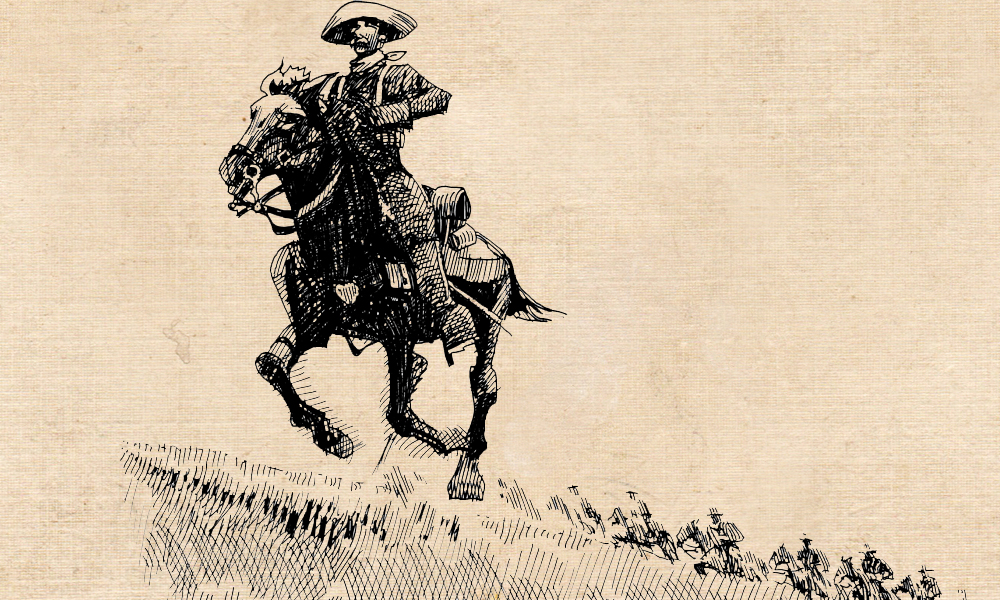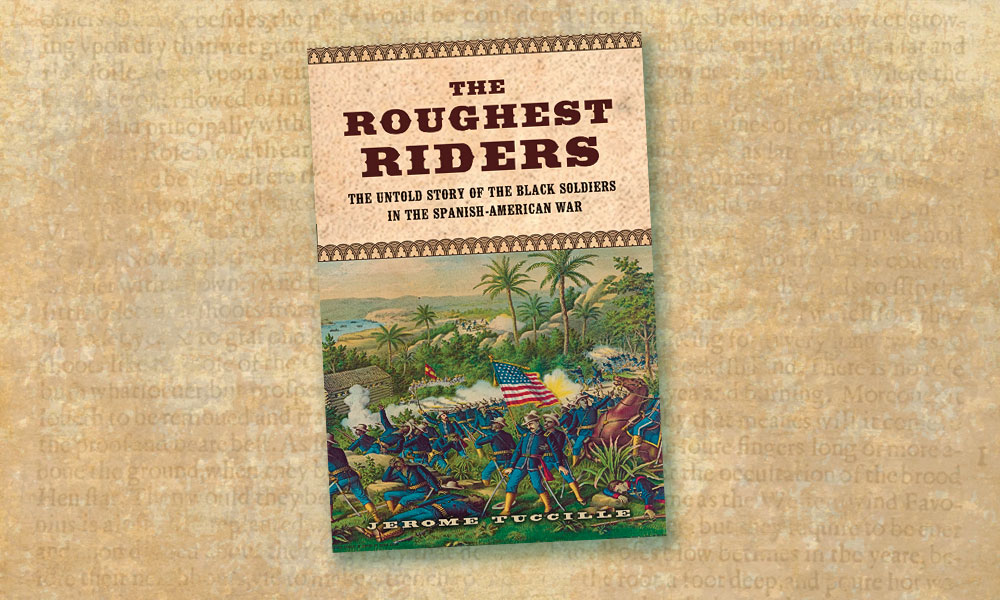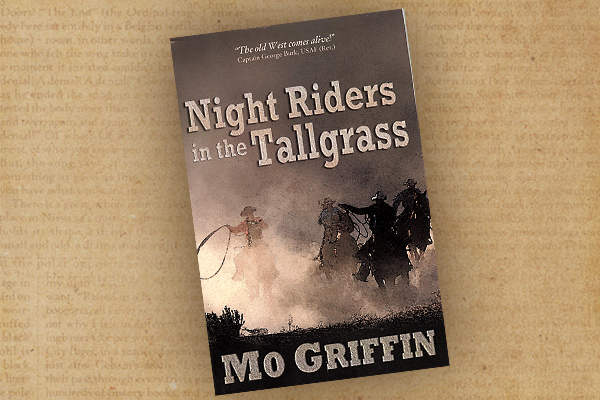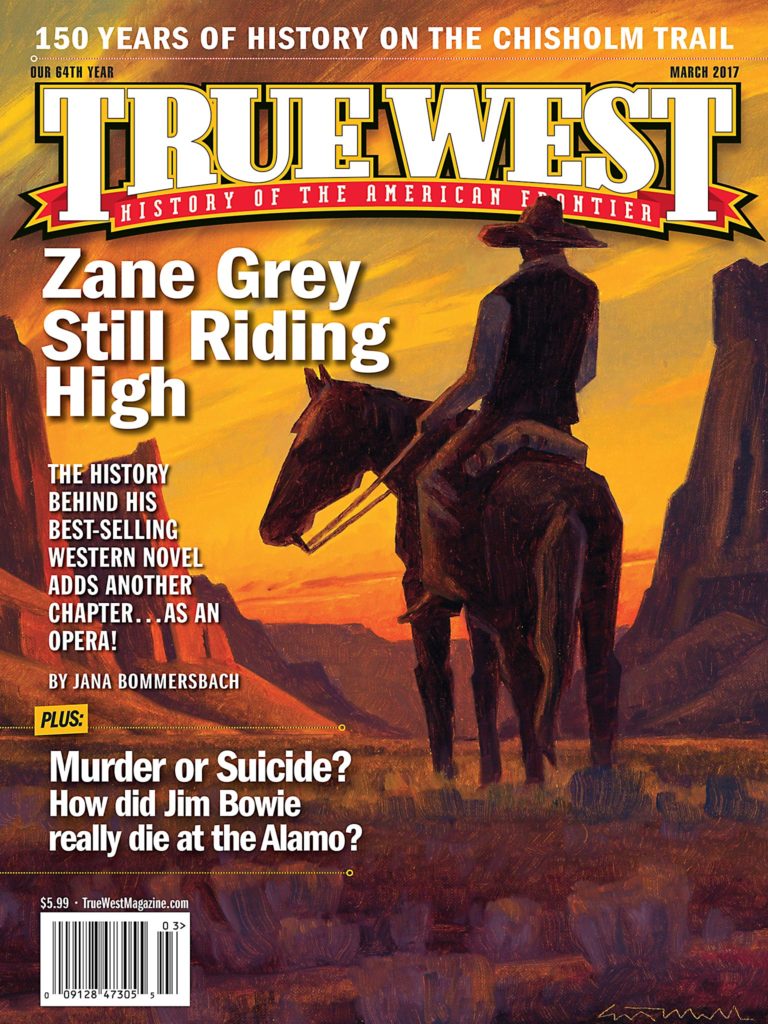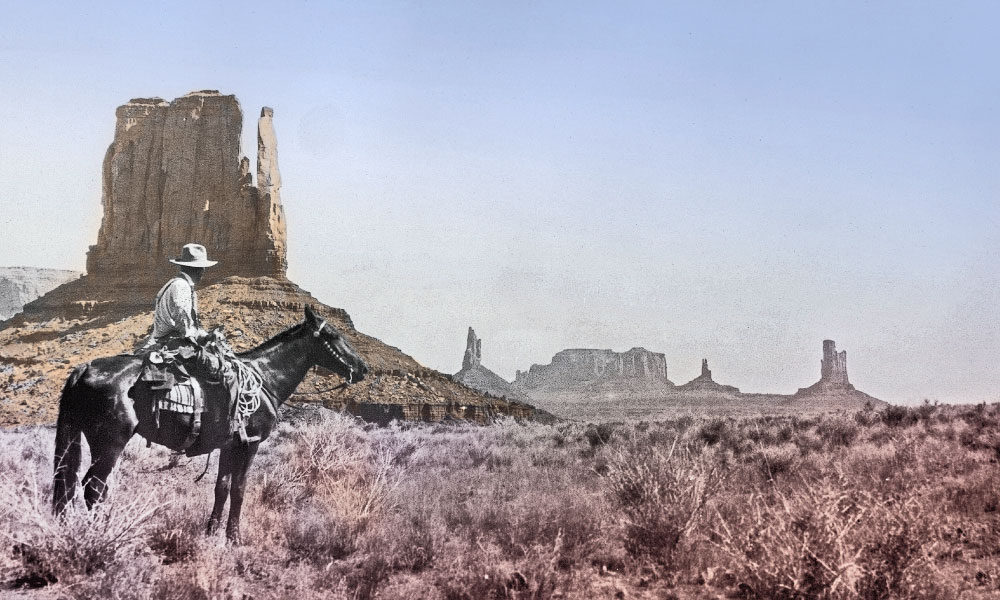
– All Zane Grey photos courtesy Zane Grey’s West Society, the Harold B. Lee Special Collections Library at Brigham Young University and Zane Grey Inc.; All illustrations by Ed Mell –
Thank the Grand Canyon.
Long before it was a national park—before it was even a game preserve, thanks to President Teddy Roosevelt—this steep-sided canyon of grandeur inspired one of the greatest storytellers of the American West.
He was a writer who touched hundreds of millions in 20 languages, telling stories of Old West ethics and codes—in glory and shame—while painting verbal scenes so vivid, the landscape became a living character.
Yes, Arizona’s Grand Canyon deserves credit because the nearly 34-year-old Zane Grey was smitten to his soul after experiencing the canyon on his honeymoon in 1906—on his wife’s dime—and on a hunting expedition in 1907. Until then, he’d been an Ohio boy, then a Pennsylvania boy, then a New York dentist with a hankering to write, but a drawer full of rejections—his first self-published books were about his historic family from days when Ohio was as far west as anyone went.
Once he experienced the spellbinding Grand Canyon—named a national park 13 years after he first saw it—he found the land and people he would bring alive in some nine million words in 58 Westerns that became 113 movies and a TV series to a worldwide audience of 250 million.
Now his most popular work—a bestselling Western novel, already five times a film—is being re-imagined by Arizona Opera to tell the 105-year-old story, Riders of the Purple Sage, all over again. The opera’s world premiere—the first ever produced by this opera company—opens in Tucson on February 25 and 26; in Phoenix, on March 3 through 5.
How fitting that this Western opera should be a tale with issues that still ring true to this day—women’s rights, fundamentalist religion, guns, the search for home. Zane would have been proud.
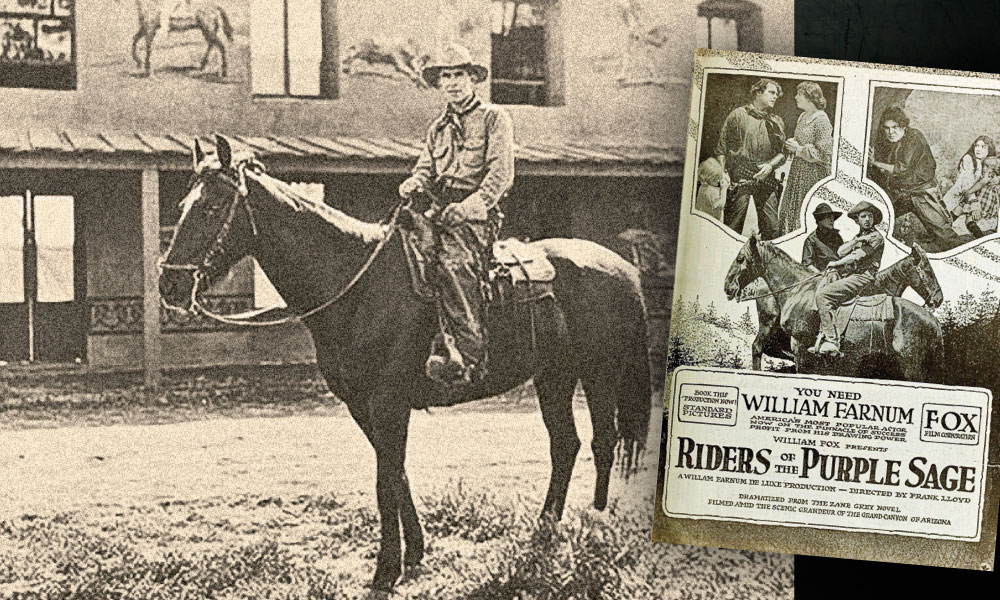
– 1918 poster courtesy Fox Film Corporation –
The Visionary
His name was so perfect for a Western writer that it sounded fake, but it wasn’t.
He was born Pearl Zane Gray on January 31, 1872—some think his first name was inspired by the gray pearls worn by a mourning Queen Victoria. He dropped the first name when he was mistakenly referred to as “Miss Gray,” and he preferred to spell his last name as Grey.
His middle name came from his mother’s family who founded Zanesville, Ohio, and carried a pioneer legacy that fascinated him enough to launch his writing career—his first self-published book was about his Great-Great Aunt Betty Zane, an American Revolution War heroine. But those were the days when he was writing while doing other things—playing baseball for the University of Pennsylvania, where he trained as a dentist; then some minor league play until he established his dental practice in New York City in 1896.
To offset the tedium of dentistry, he began writing at night. But publishers weren’t impressed with his works, and he floundered for several years.
Two life events changed that. He married Lina “Dolly” Roth in 1905, and he fell under the spell of the Grand Canyon on his first travels West.
Dolly managed his career and edited his manuscripts, always the faithful wife even though he was a most unfaithful husband. The majesty of the canyon from his trips became the template for his vivid and compelling descriptions of the Western landscape that was foreign to much of America. As he’d write, “Surely, of all the gifts that have come to me from contact with the West, this one of sheer love of wilderness, beauty, color, grandeur, has been the greatest, the most significant for my work.” America agreed.
His first bestseller was published in 1910—The Heritage of the Desert. Two years later appeared the book that defined his career, Riders of the Purple Sage. He wrote it in three months, beginning in the El Tovar Hotel at the Grand Canyon, after a trip to the Painted Desert.
Financial success allowed Zane to buy a mansion in Altadena, California, and move Dolly and their three children from Pennsylvania. He also built a hunting cabin under the Mogollon Rim near Payson, Arizona, and from 1921 to 1929, spent a few weeks each year at the cabin. He only abandoned Arizona when game officials wouldn’t give him hunting privileges out of season—he thought all his Arizona-based books owed him the courtesy. Sadly, his cabin was destroyed in the Dude Fire of 1990. But in 2005, the Northern Gila County Historical Society and the Zane Grey Cabin Foundation dedicated a replica of the cabin to showcase Zane’s work and career, on the grounds of the Rim Country Museum.
Although he didn’t know the West until well into his adulthood, he was no armchair voyeur. He hired the best guides and camped throughout the West to soak up its landscape, its folklore, its stories. He reported on what he learned like a journalist would and described it as accurately as the thousands of photographs he took. The desert invaded his soul: “Man’s bones yearn for the dust,” he wrote.
Until his death on October 23, 1939, Zane was writing and publishing from one to four books every year—and after his death, his publishers continued issuing his work, until they ran out of manuscripts in 1963. He wrote about every state west of the Mississippi River except North Dakota. Few people of the day had detailed knowledge of the American West like Zane did.
He became one of the first millionaire authors. He was a major force in shaping the myths of the Old West, not only through the millions and millions of books sold worldwide—in his heyday, he was only outsold by the Bible and the Boy Scout Handbook—but also by the film and TV productions that brought his stories to new audiences. Riders was the book that launched that movie career.
Most agree Zane had a seismic influence on filmmaking—he demanded his books be shot in the locales in which they were set, which brought filmmakers to sites throughout the West. His biographer noted that 15 years before John Ford discovered the grandeur of Monument Valley, Zane was pushing filmmakers to shoot his movies there. Zane even established his own movie studio, but after seven films, sold it to a founder of Paramount Pictures.
In all, Riders was made into a film five separate times, with the hero always getting top billing. In 1918, he was played by Hollywood sensation William Farnum; in 1925, by Western megastar Tom Mix; in 1931, by George O’Brien; in 1941, by George Montgomery; and, in the 1996 television film, by Ed Harris. It was only the last film where an actress of note played the heroine—Amy Madigan.
Nearly everything Zane wrote found its way onto the screen, with 115 adaptations of his novels and short stories.
Despite all his success, many critics hated his books; they thought them too romanticized and even denigrated him in obituaries—so much so that some critics finally came to his rescue to say something special was there. Readers weren’t so harsh—libraries to this day keep copies of his books on their shelves because so many readers want to check them out.
And the book checked out the most is Riders of the Purple Sage. It is set in 1871, the year before Zane’s birth, in Utah Territory. Ulysses S. Grant is President of the United States. Utah has been a territory for 21 years. The most significant event in Utah Territory that year was the federal government’s indictment of Mormon President Brigham Young for adultery due to his plural marriages.
Into that background, Zane sets his story around a strong-willed and determined Mormon heroine, Jane Withersteen, and a black-clad, bad-boy-but-good-man gunslinger hero named Lassiter. Jane inherited her father’s ranch and has no interest in joining the polygamous family of a church elder determined to wed her or ruin her.
The book is strongly anti-polygamy, but Zane wasn’t alone in that view. The nation was repelled by the idea of plural marriages—Mormon founder Joseph Smith’s own original wife and most of his immediate family broke with Young’s church over the issue, and the federal government tried since 1862 to outlaw the practice. It eventually succeeded after the Edmunds-Tucker Act of 1887 seized the church’s assets. The 1890 Manifesto by Mormon President Wilford Woodruff officially ended the practice and became Utah’s ticket to statehood in 1896 as the 45th state.
The Man Behind the Opera
Arizona composer Craig Bohmler didn’t read Riders of the Purple Sage until late in 2011—and he might never have if not for a moment of serendipity set in motion by an Arizona summer rainstorm.
Bohmler was in Payson, resting after a successful musical-theatre run in Branson, Missouri, looking for a new project and hoping to have a nice hike.
“But the deluge thwarted my hike, so I went to a museum in Payson devoted to Zane Grey,” he remembers. “What boy didn’t grow up with Westerns, and here was a museum filled with movie posters from [Zane’s] books. I came home that night and kindled Zane Grey. I found 28 titles and thought Riders seemed the sexiest title.”
He wasn’t 10 pages into the book when he thought, “Boy, this is operatic.” He wasn’t 30 pages into it before he knew that if the legendary Italian composer Giuseppe Verdi were still alive, he’d have taken on this book a long time ago.
“It has larger-than-life characters and big subjects,” he says. “It has a love story and an amazing landscape.”
That began a six-year journey to bring Riders to a live, operatic stage.
He called his longtime friend and frequent collaborator, Steven Mark Kohn, and announced, “I found us an opera.” That’s when Kohn first read the book—“I thought it a better opera than a book,” he admits, but came to agree, “it has all the right bones.”
As Kohn wrote the words for the opera, he found the “heart of the story is people trying to find home—everyone is seeking their place in the world,” he says.
Meanwhile, Bohmler approached Arizona Opera to see if it’d be interested. The company’s first question was: “How are you dealing with the horses?”
Bohmler never anticipated live animals on stage—neither did the opera company—but Arizona Opera suggested video might work. That didn’t sound right. Bohmler turned to a friend, Kristin Atwell Ford, who’d just won an Emmy for a film on Arizona’s Roosevelt Dam. She’d never read the book, but as Bohmler explained the story, “Ed Mell’s artwork filled my vision,” she remembers.
It didn’t take much talking to convince the internationally acclaimed Southwestern artist, known for his panoramic abstracted landscapes, to join the team. “I’ve always thought set design is something an artist should do in his lifetime,” Mell says. “This was the perfect opportunity, and it was right down my alley. I welcomed it with open arms.”
Mell created vibrant moveable panels—some 28 feet tall—and a series of sky paintings that will be projected on a giant rear screen.
Atwell Ford, coproducer of the opera, is creating a documentary, The Making of a Western Opera. She’s smitten by the projects: “This is a high-water mark for art in Arizona—an Arizona author of a piece over a century old, with the historic collaboration of Arizona native Ed Mell and Arizona resident Craig Bohmler, supported by Billy Jo and Judd Herberger, a legendary Arizona family.”
It’s also a high-water mark for bringing to life the real-world places where Zane set his novel. The creative team visited the sites in Utah and Arizona that inspired the story—the petroglyphs at Betatakin Canyon, the southern Utah ranch that the author modeled Jane Withersteen’s ranch on. Seeing the locations Zane saw so long ago inspired their depiction in the opera. Purple sage and all.
Jana Bommersbach has earned recognition as Arizona’s Journalist of the Year and won an Emmy and two Lifetime Achievement Awards. She cowrote the Emmy-winning Outrageous Arizona and has written two true crime books, a children’s book and the historical novel Cattle Kate.
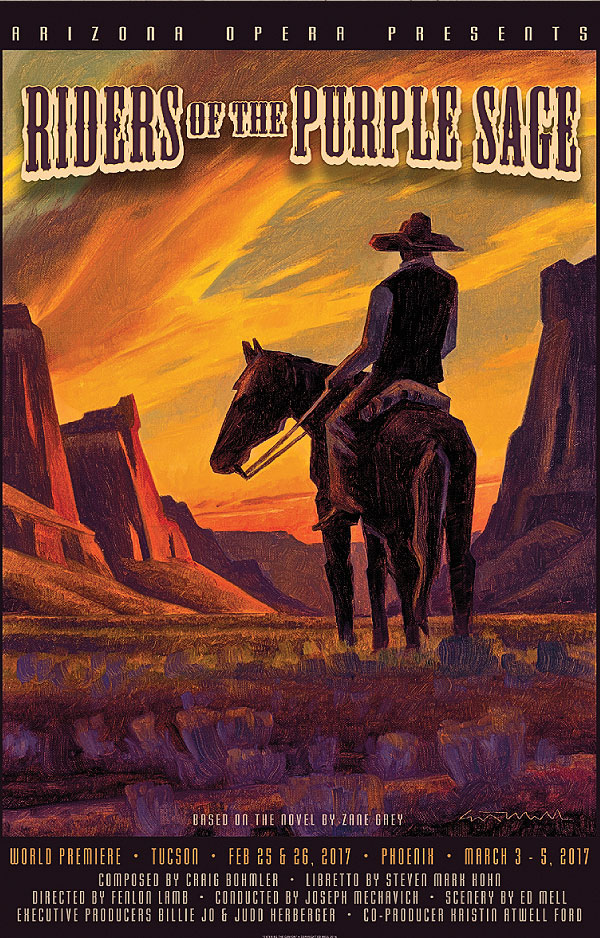
Featuring Ed Mell’s painting Entering the Canyon, this poster announces Arizona Opera’s world premiere of Riders of the Purple Sage, in Tucson on February 25 and 26, and in Phoenix on March 3 through 5. A drawing will be held during the final performance to see who wins Mell’s framed original painting, Chinle Mesa. You can enter by completing the online donation form at AZOpera.org, by calling 602-266-7334 or by speaking with an Arizona Opera staff member at one of the performances. Good luck!


